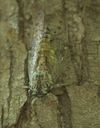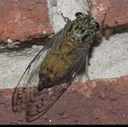Neocicada
Neocicada
Classification
- Phylum: Arthropoda
- Subphylum: Hexapoda
- Class: Insecta
- Order: Hemiptera
- Suborder: Auchenorrhyncha
- Infraorder: Cicadomorpha
- Superfamily: Cicadoidea
- Family: Cicadidae
- Subfamily: Cicadinae
- Tribe: Leptopsaltriini
- Genus: Neocicada
Pronunciation
How to pronounce Neocicada: /ˌniː.oʊ.sɪˈkɑː.də/
These audio files are automatically generated. While they are not always 100% accurate, they are a good starting point.
Images





Summary
Neocicada is a genus of translucent cicadas belonging to the family Cicadidae, with approximately five described species, including Neocicada chisos and Neocicada hieroglyphica, noted for their unique designs and environmental roles.
Physical Characteristics
Translucent body with varying coloration dependent on the species.
Identification Tips
Look for distinctive markings and coloration patterns specific to each species, such as the unique hieroglyphic patterns of Neocicada hieroglyphica.
Habitat
Neocicada species are typically found in various habitats, often favoring areas with abundant vegetation where they can conceal themselves.
Distribution
Primarily found in the Americas, with species like Neocicada chisos reported in Texas and Neocicada hieroglyphica found in the eastern United States.
Diet
As adults, Neocicada feed on plant sap using their specialized mouthparts (stylets) to pierce plants.
Life Cycle
Like other cicadas, Neocicada undergoes a life cycle that includes egg, nymph, and adult stages, with nymphs developing underground for several years before emerging as adults.
Reproduction
Mating occurs during the warmer months when males produce distinctive calls to attract females. Once mating is complete, females lay eggs in plant tissue.
Predators
Birds, small mammals, and other insects prey on Neocicada species.
Ecosystem Role
Neocicada species contribute to the ecosystem by serving as pollinators and as prey for a variety of animals.
Economic Impact
Generally minimal; however, cicadas can cause damage to trees when females lay eggs in the bark.
Cultural Significance
Cicadas have cultural significance in many regions, symbolizing rebirth and the cycle of life.
Collecting Methods
- Netting during the day when they are active
- Using sound lures to attract males
Preservation Methods
- Drying specimens in a freezer to kill any pests
- Pinning specimens for permanent display
Similar Taxa
- Cicadidae
- Chremistica
- Tibicinidae
Misconceptions
Cicadas are often confused with locusts, but they are not the same; cicadas are not harmful to crops like locusts can be.
Tags
- cicadas
- Neocicada
- insects
- Cicadidae
- hemiptera